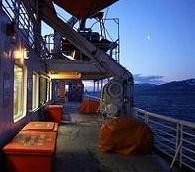Destination: Alaska
Grantland Goes to the Iditarod
by Eva Holland | 05.09.13 | 7:09 AM ET
This past March, Grantland sent writer Brian Phillips to follow the Iditarod Trail Sled Dog Race, Alaska’s famous 1000-mile feat of endurance, by bush plane. The resulting story, Out in the Great Alone, comes with all sorts of online design bells and whistles—embedded audio and video, and a map that updates itself as you scroll through the narrative. But what I liked best about it was its emphasis on place, not so much on the ins and outs of the race itself but on the landscapes and communities it passes through. Here’s Phillips:
I took a walk through the village. Couple of roads twisting down a couple of hills, some pretty rough-looking houses. Moose antlers over the doorways. Things happen to the color blue during an Alaska twilight that I’ve never seen anywhere else. Imagine that the regular, daytime blue sky spends all its time floating on the night sky, the way you’d float on the surface of a pool. Now it’s submerging itself. You could see it vanishing upward. The cars looked derelict, half-buried in snow. Snowdrifts rammed up doorknob-high against the houses. Every now and again a snow machine would go screaming by; the drivers always waved. Snow 3 and 4 feet high on the roofs.
But it was such a warm place. I mean, fine, we’re all cynics here, go ahead and click over to your next open tab or whatever, but you could feel it: this fragile human warmth surrounded by almost unmanageable sadness. Outside the checkpoint building the Takotnans had set up a row of burled tree stumps beside the flagpoles, and now two guys with chain saws were carving long crosscuts in the stumps. Each night during the Iditarod they’d pour diesel into one stump’s cuts and then light it, making a torch as wide as two people embracing that’d burn for hours and hours. Mushers coming down the river toward the checkpoint would see the torches from—I don’t know about miles, but a long way away. Eight or nine villagers, along with a few volunteers, gathered around the fire. Jay was there, talking about airplanes with Bernard—you could tell from the way he’d sort of bank his hand at the wrist and slide it through the air. Christophe went around taking pictures. A little gang of kids played king of the hill on a snowdrift. The night just dwarfed all this.
It’s a long one, but worth your time. The New Yorker also sent a writer to follow the Iditarod this year; subscribers can read Ben McGrath’s story here.
Taco Bell’s Big Alaskan Airlift
by Eva Holland | 07.15.12 | 7:00 PM ET
Last month, when I heard that residents of Bethel, Alaska, had been tricked—by a still-anonymous hoax-ster—into believing a Taco Bell franchise was coming to town, I felt a serious twinge of sympathy for my fellow Northerners. Sure, sites like Gawker had a field day with the story (“Parents looked in from bedroom doorways on their sleeping children and smiled,” they wrote at the time. “A silent prayer of thanks that sons and daughters would never know a life devoid of local fast food offerings.”) but it’s easy to snark when you’re sitting in an office in lower Manhattan, with your every heart’s desire just the swish of an iPhone away.
Geographical isolation produces strange cravings, and things that seem pedestrian, elsewhere, take on a bizarre importance. Here in Whitehorse, Canada, we’re counting down to the return of our KFC and Dairy Queen franchises—both closed several years ago—and even the healthiest of health nuts can’t wait for the grand re-openings. It’s about the injection of something new, something—anything—different into a well-worn routine. In that way, I suppose you can compare the arrival of a fast food franchise in a remote small town to the act of travel itself: Good or bad, it always shakes things up.
Anyway, Bethel’s story ends happily. Taco Bell airlifted 10,000 Doritos Locos Tacos into town to soothe the sting of the hoax, and the end result of the whole saga is this promo spot:
The Ferries and the Last Frontier
by Eva Holland | 03.26.12 | 10:43 AM ET
In a four-part series, Eva Holland explores Southeast Alaska by state ferry
The Halibut Taco is Alaska’s Unofficial State Dish. Discuss.
by Eva Holland | 02.28.12 | 7:23 AM ET
I spent nine days traveling in Southeast Alaska last month, and as I went from one panhandle port to the next, and from bar to pub to restaurant, I noticed something: the halibut taco is everywhere. It’s even outstripping such traditional Alaskan standbys as king crab legs, beer-battered halibut fish ‘n’ chips, and seafood chowder. It’s the new normal.
I’m not World Hum’s designated taco expert, by any means—Jim’s the Mexican food addict around here—but I’ve been intrigued by unexpected Mexican-in-the-sub-Arctic offerings before. And I’m no less intrigued by the halibut taco seemingly conquering the last frontier.
Alaska isn’t a state that most people associate with cutting-edge cultural fusion (though if you spend much time there, you’ll see there’s more to the place than the Discovery Channel lets on), and it seems to me that the taco’s dominance there is just one more sign of our ever-shrinking planet. I say, bring on the tasty and fascinating cultural variations.
Dispatch from the Yukon Quest Trail
by Eva Holland | 02.07.12 | 3:57 PM ET
I’m on the road this week, doing some writing and social media work for the Yukon Quest.
For those unfamiliar with it, the Quest is a 1,000-mile sled dog race that runs from Fairbanks, Alaska, to Whitehorse, Yukon (my hometown). I’m following along, and on the trail with me is a traveling crowd of volunteers, veterinarians, race officials, “handlers” (assistants to the mushers), and friends and family. We drive from checkpoint to checkpoint, meeting up with the dog teams whenever they intersect with the sparse road system. I’m writing this from Central Corner, an outpost on the Steese Highway just south of the one-time Gold Rush town of Circle City.
Never seen a long-distance dog sled race? Here’s a video that gives you a real sense of the scene at the start line back in Fairbanks:
Tom Bodett’s ‘Inside Passage’
by Michael Yessis | 01.10.12 | 11:31 PM ET
Brave and amazing storytelling in this Moth podcast by Tom Bodett, who recounts a low point in his life—he nearly blew himself up on a power line—and how he emerged from it with a realization about his father and a beautiful reason to go to Alaska. He writes about telling the story on his blog:
Standing on that stage in Burlington and telling such a personal tale, almost a confessional, in front of 1500 strangers was one of the highlights of my performing life. Until the moment I walked in front of the microphone a big part of me thought I was making a mistake. It was too personal. It was too revealing of a very low point in my character. It would make me choke up.
It was all those things and more and has made me very happy.
Made me choke up, too.
‘Back to the Wild’: More on Christopher McCandless
by Eva Holland | 04.01.11 | 12:44 PM ET
The Fairbanks Daily News-Miner reports that members of the McCandless family recently traveled to Alaska to visit the old school bus where one of their own, Christopher McCandless, died. The visit was part of a promotional effort for a new book (and accompanying DVD), Back to the Wild, which will showcase McCandless’ photos and writing. Profits from the book will go to a non-profit aimed at helping “new mothers in need.”
As always, McCandless and his bus are a contentious subject in Alaska. After describing the parents’ visit, News-Miner writer Dermot Cole adds:
I have long believed that the junked bus ought to be moved, largely because it’s an attractive nuisance. With people ripping off additional parts of the bus as time goes by, it makes more sense to move it closer to Healy or somewhere else.
Year after year, a steady stream of unprepared people risk their lives trying to get to what would otherwise be seen as an example of environmental blight instead of a shrine.
Is ‘Sarah Palin’s Alaska’ Worth Watching, ‘Just for the Scenery’?
by Eva Holland | 11.22.10 | 4:21 PM ET
Jaunted checked out the new reality show and came back with an answer: “You betcha.”
Happy Birthday, Alaska Highway
by Eva Holland | 10.29.10 | 4:34 PM ET
The road, built in the midst of World War II thanks to fears of a Japanese invasion, turns 68 today. It’s come a long way since its opening to military traffic—when, according to Wired writer Tony Long, it was “a glorified footpath with stretches of unpaved road, murderous switchbacks and no guard rails or shoulders”—but I still think it makes for one of the great North American drives. Here’s to many more road trips yet to come.
What We Loved This Week: Rachid Taha, Fall Colors at Alaska’s Denali Park and More
by World Hum | 09.03.10 | 3:49 PM ET
Jim Benning
Algerian musician Rachid Taha. I discovered him recently on a flight—he was a featured artist on Delta’s in-flight audio entertainment system. He has covered the Clash’s “Rock the Casbah.” Here’s a taste of something perhaps slightly less familiar:
Swiss Hiker Drowns Near McCandless Bus
by Eva Holland | 08.24.10 | 2:05 PM ET
The 29 year-old woman, Claire Ackermann, died while crossing the Teklanika River on the Stampede Trail this weekend. Her companion told state troopers that they weren’t on their way to visit the old school bus where Christopher McCandless died in 1992, but the incident has renewed concerns about McCandless pilgrims nonetheless.
The Anchorage Daily News story about Ackermann’s death notes a number of recent near-misses for other hikers attempting the crossing, and one local resident told the paper: “Honestly, I’m amazed this hasn’t happened earlier.” (Via @lunaticcarl)
In Alaska, ‘There Are No Easy Flights’
by Eva Holland | 08.12.10 | 12:01 PM ET
In the wake of the plane crash that killed former U.S. Senator Ted Stevens and four others this week, James Fallows digs into “the unique world of Alaskan aviation,” noting that it’s “more dangerous than elsewhere in the country, but also more necessary.”
Paddling the Alaskan Food Chain
by James Michael Dorsey | 07.19.10 | 11:45 AM ET
James Michael Dorsey was enjoying a quiet kayaking outing on Alaska's Inside Passage. Then he spotted a dorsal fin.
‘‘Remote’ is a Word We Like to Misuse’
by Eva Holland | 07.15.10 | 9:49 AM ET
Dave Weigel is blogging this week from an island way out in the Aleutians. Here’s his introduction to Dutch Harbor, Alaska:
There is usually some diversity of companions on an airplane. Not on this one. The men have beards and gear and heavy boots; the women have all but one of these things. Your fellow travelers look like they’re heading to the same bar after work, possibly because they are. Another thing you notice is that most of them have shirts or jackets with “Alaska” written on them. This seems odd—you don’t head into Newark and bump into travelers with “New Jersey” jackets. Then you realize you’re being foolish, and that almost everyone you’re flying with works for some Alaska company, in construction or fishing or research, and that they’re wearing the raincoats they’ve been handed for free.
Audio Story: Tagish Elvis and Me
by Pam Mandel | 06.23.10 | 8:50 AM ET
In Skagway, Alaska, Pam Mandel finds an unlikely way to salvage a bad trip
- « Prev Page
- Next Page »



